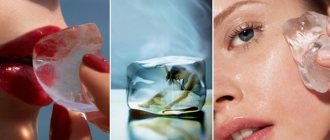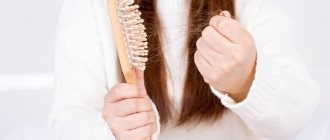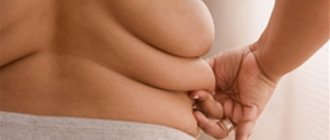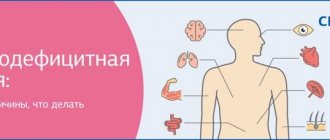The text is for informational purposes only. We strongly urge you not to use diets, resort to any therapeutic menus or fasting without medical supervision. We recommend reading: “Why you can’t go on a diet on your own.”
Nutritional rules for urticaria are a carefully selected list of products and a compiled menu that does not contain allergens, a diet as part of active therapy. Urticaria is a rash all over the body; rashes can even appear on human mucous membranes. In case of improper treatment or lack of an appropriate diet, the disease can become chronic.
The importance of following a diet for food allergies
To understand the relationship between nutrition and skin manifestations of an allergic reaction, it is necessary to understand the mechanism of sensitization. Allergy cannot be fully considered a disease. It is an atypical response of the immune system resulting from contact with a certain substance that normally should not cause sensitivity. Allergens can include food, plant pollen, animal waste products, household chemicals, even sunlight and water.
The skin is a kind of indicator reflecting the general condition of the body. If a person has an atypical immune response to a particular substance, it is the skin that first suffers from such sensitization. Symptoms of skin allergies include small and large rashes, accompanied by itching, burning and soreness, swelling and redness of the skin.
Eating certain foods can both provoke the onset of an allergic reaction and aggravate existing symptoms of sensitization. For this reason, during a period of exacerbation of allergies, it is advisable to completely exclude trigger foods from the diet and adhere to certain rules for processing and eating food. Following a diet for skin allergies, as well as following medical recommendations and taking prescribed medications is a real opportunity to cope with the unpleasant manifestations of sensitization and strengthen the body's defenses.
General rules
Food allergies ( urticaria , angioedema and others) are based on individual immunoconflict reactions to certain protein antigens contained in food products, which are absolutely harmless to most other people.
Urticaria is a group of diseases of various etiologies and is manifested by skin elements in the form of an urtic rash (blisters) localized both on the surface of the skin and on the mucous membranes, gradually enlarging and merging with each other and accompanied by itching. The most common is allergic urticaria, which is caused by various types of allergens, including food products. In principle, almost all food products are allergenic to one degree or another.
Below is a list of the most common food allergens:
- products containing animal proteins: milk, eggs, seafood;
- cereals: wheat, rice, rye, barley, corn, oats, cane;
- cruciferous vegetables: cabbage (white cabbage, Brussels sprouts, cauliflower), mustard, turnip, horseradish, radish;
- pumpkin: cucumber, pumpkin, watermelon, melon, zucchini;
- citrus fruits (tangerines, oranges, lemons);
- Compositae: artichoke, chicory, lettuce, sunflower;
- legumes: lentils, beans, soybeans, peas;
- buckwheat: buckwheat, rhubarb;
- nightshades: tomatoes, potatoes, red and green peppers, eggplants;
- heathers: cranberries, blueberries, lingonberries;
- Rosaceae: strawberry, wild strawberry, plum, pear, apple, peach, apricot, almond;
- umbelliferous: dill, parsley, celery, onion;
- Liliaceae: onion, asparagus, garlic;
- histamine liberators (products that do not cause allergies in themselves, but provoke the release of the allergy mediator - histamine : food additives in the form of flavors, dyes, preservatives, chocolate, coffee, vinegar, smoked meats, mustard, mayonnaise, alcohol).
A diet for urticaria in adults is an essential component of treatment and is aimed at excluding (eliminating) foods (if known) that provoke allergic reactions from the patient’s diet. If such a food agent is not identified, then an elimination diet can also be used for diagnostic purposes. In general, a diet for food allergies should be based on the following principles:
- exclude from your diet food agents known to you that provoke allergic reactions and foods that cause a cross-reaction in you (for example, all red vegetables, berries and fruits);
- Avoid excess protein content in the diet;
- do not include unknown or genetically modified products on the menu;
- eat simple food containing a minimum of ingredients, exclude complex dishes, including various seasonings and sauces;
- use only fresh products, avoid shelf-stable products (canned food, preserves);
- give preference to homemade dishes, do not include semi-finished products in your diet;
- try to optimally diversify the menu, since a product that is often eaten can have a sensitizing effect;
- limit the consumption of table salt and simple carbohydrates, as well as fried, spicy and salty foods;
- Completely avoid drinking alcoholic beverages.
Despite the fairly large list of foods to be excluded or limited, a hypoallergenic diet should be physiologically complete, but not excessive in energy value and micronutrient (especially proteins). Allergenic foods and dishes containing them even in minimal quantities are excluded from the diet. So, if you are allergic to chicken eggs, avoid creams, mayonnaise, baked goods, casseroles and all dishes that contain eggs in the recipe.
If the allergic trigger is not known, then the diet is limited to foods that most often cause an allergic reaction - eggs, milk, fish, seafood, citrus fruits, fish caviar, tomatoes, chocolate, honey, strawberries, melon, nuts. At the same time, it must be taken into account that prolonged heat treatment of products reduces their allergic properties. In chicken eggs, proteins are of great allergic significance.
Easily digestible carbohydrates (sugar and products containing it - sweets, jam, confectionery), chocolate, honey are subject to restrictions, thereby reducing the inflammatory process. Sugar can be replaced with saccharin , xylitol , and sweetener . The diet increases the content of vitamins and bioflavonoids , which strengthen the walls of blood vessels. The consumption of salt and salty foods is significantly limited.
The diet is enriched with foods rich in calcium (fermented milk drinks, cottage cheese), which has anti-allergic and anti-inflammatory effects. At the same time, limit the diet to foods containing a high amount of oxalic acid, which reduces the absorption of calcium.
Some types of fish are subject to exclusion (herring, mackerel, tuna, and “red” fish, the meat of which contains a large amount of histamine, which increases allergic reactions). Almost all crustaceans (crabs, shrimp, crayfish, lobsters) have pronounced cross-antigenicity, therefore, in case of intolerance to one species, it is necessary to exclude other species from the diet.
Spices and seasonings, strong meat, mushroom and fish broths, spicy dishes, smoked foods and sauces are excluded or limited. Milk globulins have pronounced allergic properties, which should also be excluded. It is preferable to prepare dishes by boiling or baking; frying foods is prohibited. Chemical sparing of the gastrointestinal tract reduces the absorption of allergenic triggers in the intestines. To improve the digestion of potential allergens - food proteins, it is necessary to practice fractional meals and a reduced portion size.
Urticaria in adults can occur in both acute and chronic forms with periodic exacerbations and remissions, and each of these forms has the specifics of therapeutic nutrition. During an exacerbation, a hypoallergenic diet that is extremely limited in the range of products (to which there is no allergic reaction) is prescribed.
As the clinical manifestations subside, various vegetables and fruits are introduced into the diet in small doses: first, green or yellow in color, and after a few days, in the absence of rashes, representatives of these families of orange (pumpkin) and red color. In small quantities, boiled fish of low-fat white varieties, white bread, fresh onions, fruit puree and freshly squeezed juices, compotes are introduced into the diet.
Main features of the diet for skin allergies in adults and children
A specialist should be involved in preparing a balanced diet that excludes the consumption of trigger foods. Based on laboratory tests and specialized tests, an allergist (or dermatologist) will be able to determine not only the allergen that provokes sensitization, but also substances that are similar in structure and can also cause unpleasant symptoms. Only a doctor can make a list of permitted and prohibited products, taking into account the individual characteristics of the patient - such as the intensity of the atypical reaction, age, gender, general health and the presence of concomitant diseases.
If at the moment you do not have the opportunity to visit a doctor, you can use some general recommendations regarding the preparation of a diet for skin allergies in adults and children:
- Meals should be fractional. If you eat food in small portions 5-6 times a day instead of the usual 3 (breakfast, lunch and dinner), its digestion will occur faster and better. As a result, the load on the gastrointestinal tract will be reduced.
- It is important to cook food properly. Instead of frying foods (especially deep-frying), it is advisable to give preference to stewing, boiling, steaming, and baking in an oven. It is also necessary to consume permitted vegetables and fruits in raw, fresh form.
- The diet for skin allergies in children and adults should be balanced. Despite the fact that protein is usually the culprit for an atypical reaction in the body, it is not advisable to completely exclude it from the diet. Also, do not forget about saturating the body with vitamins and minerals. If some beneficial substances enter the body with food in insufficient quantities, you can discuss with your doctor the advisability of taking vitamin-mineral complexes.
- When drawing up a dietary menu for skin allergies, you need to take into account the possibility of a cross-reaction. Some substances have similar amino acid structures, causing the immune system to mistakenly react to them in the same way as to an allergenic substance. In this case, a cross-reaction can extend not only to food, but also to other groups of allergens (household, pollen, medications, etc.) To exclude the possibility of cross-reactions, when creating a menu, it is recommended to familiarize yourself with the tables that provide a list of substances that have similar structure. For example, a diet for allergies to cereal grasses and pollen involves avoiding baked goods, wheat and malt beer, bread kvass, chicory, sunflower oil and seeds.
- To reduce the intensity of the allergic reaction, it is advisable to avoid the consumption of alcohol and refined sugar.
- To assess the safety of food products for skin allergies, it is recommended to keep a food diary. It should include the following columns: date and time of food intake, name, composition, quantity and method of preparation of the food eaten, description of the skin reaction. It is advisable to keep entries in the diary on an ongoing basis for 1-2 months, after which you need to analyze the body’s reaction to certain foods. It is also recommended to make appropriate notes after introducing new dishes into the diet.
Varieties
Elimination diagnostic diet
As stated, the optimal treatment option for hives when a causative food agent is identified is to remove or avoid it. However, if such an agent is not identified, elimination diets are used for diagnostic purposes, the procedure for which is given below. It is carried out in a hospital setting.
The patient is prescribed complete fasting for 3-5 days with a free fluid intake of 1.5 liters per day. Before fasting, the patient takes a saline laxative ( magnesium sulfate ) once. Every day during fasting, cleansing enemas are performed, light physical activity and two showers are required. As a rule, during fasting, the symptoms of urticaria , and new rashes do not appear.
One type of product is introduced into the patient’s diet, which is taken on an empty stomach in the morning in the amount of 100 g and then, 4 times a day, 200 g for 2 days. Every 2 days a new product is added to the previously introduced one. At the same time, every morning a provocative test is carried out with the intake of the connected product. It is recommended to start forming a diet with vegetables, for example, boiled potatoes, after 2 days carrots are introduced, then bread products, dairy products, beef, chicken, fish, eggs and so on.
Lastly, those foods that, in the patient’s opinion, cause an exacerbation are introduced into the diet. The appearance of fresh rashes after taking any of the studied products confirms its significance in the occurrence of an allergic reaction. On this day (if a reaction occurs), fasting for 24 hours and cleansing enemas without taking medications are again prescribed. After the disappearance of allergic rashes the next morning, a new, untested product is introduced and a provocative test is performed. Over the next two days, already researched and well-tolerated food products with newly connected ones are introduced into the menu.
Thus, thanks to the elimination diagnostic diet, it becomes possible to create a basic diet (basic foods) for each specific patient. If it is necessary to further expand the diet, new products are introduced no earlier than once every 3 days. It is recommended to keep a special “food diary”, which reflects the patient’s body’s reaction to all newly introduced foods. At the same time, you need to be extremely careful with identified allergenic products, eliminating them from the diet not only in their pure form, but also monitoring their presence in other dishes, as well as products that have cross-properties with the allergen.
Types of nutrition for allergies: which diet is relevant in a particular case?
If a person is sensitized to a specific allergen or group of them, his diet may be:
- Eliminative. The elimination diet menu for skin allergies is designed so that it does not contain the allergen substance. At the same time, other moderately and even highly allergenic products can be allowed for consumption in reasonable quantities. For example, if a patient has an increased sensitivity to plant protein (gluten), the allergy diet excludes the consumption of cereals and soups made from wheat, rye, barley and oatmeal, as well as dishes made from these types of flour. Instead, it is recommended to include special gluten-free varieties of bread, legumes, nuts, meat, fish and eggs in the diet. As a result, the lack of protein caused by avoiding gluten is compensated by obtaining it from approved foods.
- Basic. Basic nutrition involves eating hypoallergenic foods and completely avoiding all potential allergens. It is especially relevant if the product that provokes an atypical reaction of the body is unknown. In most cases, it is recommended to adhere to such a diet during periods of acute allergies, as well as in the presence of polyvalent allergies.
What can you eat if you have hives?
The diet for urticaria during the treatment period is not very varied, but a person will not go hungry. Doctors recommend a diet consisting of the following foods:
- lean meat (chicken, turkey, rabbit);
- green or white vegetables (potatoes, cabbage, zucchini);
- light-colored fruits (apples, pears, yellow cherries);
- cereals (buckwheat, rice, millet);
- pasta from durum wheat;
- bread with bran or whole grain;
- vegetable oils (sunflower, corn, olive);
- cracker;
- products made from sour milk (kefir, fermented baked milk, natural yogurt, low-fat cottage cheese);
- green tea.
If the patient’s condition stabilizes, then new foods can be added to the diet every 2-3 days. Do not consume more than 1 product at a time, and at the same time you should listen to your body, assessing its reaction. It is appropriate to start expanding your diet with orange vegetables (pumpkin or carrots) and boiled low-fat fish.
Particularly strict restrictions should be followed for 2-3 weeks from the moment of the crisis. A more gentle diet will have to be followed for at least 1.5 months.
Diet for allergies: what can and cannot be eaten?
All products are divided into three categories:
- Highly allergenic. This group includes products that most often cause an atypical reaction. These include both animal and plant foods: cow's milk and products made from it, chicken, eggs, seafood (especially crustaceans), fish; sunflowers, nuts, wheat, red and orange fruits and vegetables, citrus fruits, mushrooms. In addition to these products, an increased risk of developing or intensifying allergies is observed when consuming smoked, salted and pickled foods, fast food, trans fats, alcohol, artificial emulsifiers, preservatives and flavorings.
- Moderately allergenic. This group includes lean pork, legumes, bananas, buckwheat, peaches and plums, and corn.
- Low allergenic. An anti-allergy diet may include such safe foods as zucchini, white currants, fresh cucumbers, greens, turnips, cabbage, lean lamb, horse meat, and rabbit.
Fully or partially limited products
The diet for acute/chronic urticaria involves the complete exclusion of such products as fatty red meats, strong meat and fish broths, as well as first courses based on them, duck, goose, smoked meats, most sausages, whole milk, chicken eggs, fish, especially , “red” fish of all kinds.
Citrus fruits, chocolate, seafood (shrimp, mussels, squid), flour products and sweets, honey and honey products (propolis, bee jelly, wax), any salty foods, canned food, pickled vegetables, animal and cooking fats, salty and fatty are prohibited. cheeses, cream, sweet curds, sour cream.
All products containing easily digestible carbohydrates are excluded - sugar and products containing it, honey, jams, preserves, sweets, confectionery, ice cream. Semolina, rice and pasta, and soy are subject to restrictions.
Red and orange fruits/vegetables (tangerines, red apples, oranges, tomatoes, radishes, beets, radishes, carrots, strawberries, strawberries), nuts (especially peanuts and hazelnuts) are excluded from the diet; coffee; vinegar, all seasonings (mustard, ketchup, horseradish, mayonnaise), mushrooms, eggplant, pineapple, melon, butter dough.
The hypoallergenic menu should not include products containing food additives (dyes, preservatives), fruit tea, fruit/vegetable juices from prohibited berries, vegetables and fruits, sweet carbonated drinks and any alcohol-containing drinks.
Table of prohibited products
| Proteins, g | Fats, g | Carbohydrates, g | Calories, kcal | |
Vegetables and greens | ||||
| carrot | 1,3 | 0,1 | 6,9 | 32 |
| salad pepper | 1,3 | 0,0 | 5,3 | 27 |
| tomatoes | 0,6 | 0,2 | 4,2 | 20 |
Fruits | ||||
| bananas | 1,5 | 0,2 | 21,8 | 95 |
| pomegranate | 0,9 | 0,0 | 13,9 | 52 |
| grapefruit | 0,7 | 0,2 | 6,5 | 29 |
| lemons | 0,9 | 0,1 | 3,0 | 16 |
| mango | 0,5 | 0,3 | 11,5 | 67 |
| tangerines | 0,8 | 0,2 | 7,5 | 33 |
Berries | ||||
| grape | 0,6 | 0,2 | 16,8 | 65 |
| Red currants | 0,6 | 0,2 | 7,7 | 43 |
Nuts and dried fruits | ||||
| nuts | 15,0 | 40,0 | 20,0 | 500 |
| raisin | 2,9 | 0,6 | 66,0 | 264 |
Cereals and porridges | ||||
| white rice | 6,7 | 0,7 | 78,9 | 344 |
Confectionery | ||||
| jam | 0,3 | 0,2 | 63,0 | 263 |
| jam | 0,3 | 0,1 | 56,0 | 238 |
| candies | 4,3 | 19,8 | 67,5 | 453 |
| pastry cream | 0,2 | 26,0 | 16,5 | 300 |
Ice cream | ||||
| ice cream | 3,7 | 6,9 | 22,1 | 189 |
Chocolate | ||||
| chocolate | 5,4 | 35,3 | 56,5 | 544 |
Raw materials and seasonings | ||||
| ketchup | 1,8 | 1,0 | 22,2 | 93 |
| mayonnaise | 2,4 | 67,0 | 3,9 | 627 |
| honey | 0,8 | 0,0 | 81,5 | 329 |
Dairy | ||||
| cream | 2,8 | 20,0 | 3,7 | 205 |
| sour cream 30% | 2,4 | 30,0 | 3,1 | 294 |
| sour cream 40% (fat) | 2,4 | 40,0 | 2,6 | 381 |
Cheeses and cottage cheese | ||||
| cheese | 24,1 | 29,5 | 0,3 | 363 |
| cottage cheese 18% (fat) | 14,0 | 18,0 | 2,8 | 232 |
Meat products | ||||
| pork | 16,0 | 21,6 | 0,0 | 259 |
| pork liver | 18,8 | 3,6 | 0,0 | 108 |
| pork fat | 1,4 | 92,8 | 0,0 | 841 |
| salo | 2,4 | 89,0 | 0,0 | 797 |
| beef liver | 17,4 | 3,1 | 0,0 | 98 |
| mutton | 15,6 | 16,3 | 0,0 | 209 |
Sausages | ||||
| smoked sausage | 16,2 | 44,6 | 0,0 | 466 |
| smoked sausage | 9,9 | 63,2 | 0,3 | 608 |
| sausages | 10,1 | 31,6 | 1,9 | 332 |
| sausages | 12,3 | 25,3 | 0,0 | 277 |
Bird | ||||
| smoked chicken | 27,5 | 8,2 | 0,0 | 184 |
| duck | 16,5 | 61,2 | 0,0 | 346 |
| smoked duck | 19,0 | 28,4 | 0,0 | 337 |
| goose | 16,1 | 33,3 | 0,0 | 364 |
Eggs | ||||
| chicken eggs | 12,7 | 10,9 | 0,7 | 157 |
Fish and seafood | ||||
| smoked fish | 26,8 | 9,9 | 0,0 | 196 |
| salted fish | 19,2 | 2,0 | 0,0 | 190 |
| Red caviar | 32,0 | 15,0 | 0,0 | 263 |
| black caviar | 28,0 | 9,7 | 0,0 | 203 |
| canned fish | 17,5 | 2,0 | 0,0 | 88 |
| semi-finished fish products | 12,5 | 6,7 | 14,7 | 209 |
| sardine | 20,6 | 9,6 | — | 169 |
| mackerel | 18,0 | 13,2 | 0,0 | 191 |
| cod (liver in oil) | 4,2 | 65,7 | 1,2 | 613 |
Oils and fats | ||||
| creamy margarine | 0,5 | 82,0 | 0,0 | 745 |
| coconut oil | 0,0 | 99,9 | 0,0 | 899 |
| palm oil | 0,0 | 99,9 | 0,0 | 899 |
| rendered beef fat | 0,0 | 99,7 | 0,0 | 897 |
| cooking fat | 0,0 | 99,7 | 0,0 | 897 |
| rendered pork fat | 0,0 | 99,6 | 0,0 | 896 |
Alcoholic drinks | ||||
| white dessert wine 16% | 0,5 | 0,0 | 16,0 | 153 |
| dry white wine | 0,1 | 0,0 | 0,6 | 66 |
| vodka | 0,0 | 0,0 | 0,1 | 235 |
| cognac | 0,0 | 0,0 | 0,1 | 239 |
| liquor | 0,3 | 1,1 | 17,2 | 242 |
| beer | 0,3 | 0,0 | 4,6 | 42 |
Non-alcoholic drinks | ||||
| cola | 0,0 | 0,0 | 10,4 | 42 |
| black coffee | 0,2 | 0,0 | 0,3 | 2 |
| Pepsi | 0,0 | 0,0 | 8,7 | 38 |
| sprite | 0,1 | 0,0 | 7,0 | 29 |
| tonic | 0,0 | 0,0 | 8,3 | 34 |
| energy drink | 0,0 | 0,0 | 11,3 | 45 |
| * data is per 100 g of product | ||||
Diet for allergies in adults: menu for 4 days
Creating a balanced daily diet depends on which product is likely to cause an atypical reaction in you. Below is an example of a basic skin allergy diet that excludes several common allergens.
The first day
Breakfast: buckwheat porridge with water, cabbage and greens salad with olive oil dressing.
Second breakfast: potato pancakes.
Lunch: vegetable soup, stewed cabbage with boiled beef.
Afternoon snack: cottage cheese with herbs and cucumbers.
Dinner: zucchini stew, steamed lean pork cutlets.
Second day
Breakfast: oatmeal with water and dried fruits.
Second breakfast: biscuits.
Lunch: vegetarian borscht, pilaf with lean lamb.
Afternoon snack: yogurt without additives.
Dinner: apples of approved varieties (Simirenko, White filling, etc.), baked with cottage cheese.
Day three
Breakfast: millet porridge with allowed fresh vegetables, biscuits.
Second breakfast: zucchini pancakes.
Lunch: pea soup with vegetable broth, potato casserole with stewed rabbit.
Afternoon snack: kefir.
Dinner: boiled wild rice with boiled beef tongue.
Day four
Breakfast: oatmeal with dried fruits, green tea.
Second breakfast: banana.
Lunch: rice soup with vegetable broth, steamed rabbit meatballs.
Afternoon snack: compote of permitted fruits.
Dinner: buckwheat porridge with water, cabbage and cucumber salad.
Expert recommendations after recovery
- Be sure to enrich your body with vitamin C to normalize the immune system.
- Introduce foods with a high content of quercetin, which is an anti-inflammatory and antihistamine substance (found in capers, onions, apples, citrus fruits, cherries, tea, berries).
And also warn all the doctors you contact that you have had hives in order to avoid taking those medications that cause allergic reactions in your body.
Urticaria is one of the dermatological diseases, called “polyetiological dermatosis”. Hives appear on human skin in the form of pink or pink-red blisters, which are very similar to the effects of a nettle burn. The causes of this disease are an allergic reaction to:
- medications (antibiotics, serums, analgesics);
- food (eggs, seafood, canned food, mushrooms, citrus fruits, berries);
- insect bites (wasps, bees, fleas, mosquitoes);
- weather conditions (heat, cold, solar radiation, etc.);
- disorders of hormonal and endocrine systems, infections, stress;
- household chemicals (detergents, washing powders, soap, shampoos);
- irritants of animal origin (fur, saliva of cats, dogs);
- neoplasms.
But still, the main reason for the appearance of urticaria in adults is considered to be heredity - did you have any relatives in your family with allergies.
- Types of urticaria
- Diet for urticaria
- Expert recommendations after recovery
Diet for allergies in children
Allergic reactions in children are quite common. For some children, the tendency towards them is inherited. It is believed that if one of the parents is sensitized to any allergen, the likelihood of an atypical reaction in the child is 50%. If increased sensitivity is observed in both parents, this risk increases to 60-70%.
In childhood, sensitization to cow's milk protein is quite common. If the child is bottle-fed, the likelihood of developing such sensitization increases. In this case, the issue of following a diet for milk allergies becomes relevant. For babies under one year old, regular milk formulas can be replaced with formulas containing hydrolyzed cow's milk proteins. The introduction of complementary foods (hypoallergenic vegetable, fruit, berry and meat purees) to children with allergies should be carried out gradually.
Nutrition for skin allergies in children after one year has the same features as in adults. The only difference is that it is more difficult for children of preschool and school age to comply with restrictions and especially refuse sweets. To eliminate the risk of accidental consumption of prohibited foods (for example, in a kindergarten or school cafeteria), you can prepare children’s lunches at home and give them with them.
Advantages and disadvantages
| pros | Minuses |
|
|
Diet of a nursing mother for allergies in a child
Breastfeeding is one of the necessary conditions for the development of the baby’s immunity. Together with mother's milk, the baby receives the necessary nutrients - immunoglobulins, vitamins, minerals, enzymes.
If an allergic child is breastfed, responsibility for following the diet falls on the mother's shoulders. As long as a woman breastfeeds her baby, she should avoid consuming highly and moderately allergenic foods and drinks. It is advisable to observe these restrictions for at least six months - during this period the baby’s immune system is especially vulnerable. Starting at six months of age, hypoallergenic complementary foods can be gradually introduced. In this case, it is necessary to keep notes in a food diary, noting in it the child’s reaction to this or that type of complementary feeding.
For children
The diet for urticaria in children aged 2 years and older is based on similar principles. However, it must be taken into account that nutrition must correspond to age-related needs for macro- and micronutrients. For a child under one year of age who is breastfed and has allergies, the nutritional strategy should be as follows: adhere to a hypoallergenic diet (when the child is fed only breast milk, the mother must adhere to this diet).
When introducing complementary foods, it is not recommended to immediately exclude vital nutrients, in particular, proteins of animal origin (cottage cheese, meat, dairy and fermented milk products), vegetables, and fruits. In such cases, an individual approach to the selection of complementary feeding products is required, taking into account their tolerance. At the same time, you need to strive to expand, not narrow, the diet. We should not forget that in children of this age, the digestive system is not fully adapted to digesting various foods, so any diet with food restriction should be temporary in order to transfer the child to a normal, age-appropriate diet when the adaptation systems are ready.
La-Cri products and their help in treating allergies
In addition to diet and taking antihistamines, the use of La-Cri cream for sensitive skin helps reduce the manifestations of an allergic reaction on the skin. The product contains active ingredients such as string, walnut and violet extracts, panthenol, bisabolol and avocado oil. The use of the cream helps reduce itching, redness and flaking of the skin - symptoms characteristic of allergies. The composition of the cream is absolutely safe, it does not contain hormones and parabens, so it can be used by pregnant women and children from birth.
Types of urticaria
There are several of them:
- Allergic. Occurs when allergens enter the human body, causing a response from the immune system.
- Pseudoallergic is the body’s reaction to illness or past infections, without the participation of the immune system.
- Physical – as a result of physical, most often weather, factors (cold, aquagenic, solar, vibration).
- Medication is caused by the use of medications that are poorly tolerated by the body.
- Idiopathic – without a specific cause.
Symptoms of the disease in adults:
- severe itching;
- pink or red blisters;
- increased body temperature (up to 39 degrees);
- changes in blood pressure;
- labored breathing;
- swelling.
Clinical researches
The conducted clinical study proves the high efficiency, safety and tolerability of products for daily skin care of children and adults with mild and moderate forms of atopic dermatitis and during remission, accompanied by a decrease in the quality of life of patients. As a result of therapy, a decrease in the activity of the inflammatory process, a decrease in dryness, itching and flaking was noted.
Clinical research has confirmed the following properties of La-Cri cream for sensitive skin:
- Removing redness;
- Skin moisturizing;
- Gentle skin care.
Based on the results of joint research, the following information is placed on product packaging: “Recommended by the St. Petersburg branch of the Union of Pediatricians of Russia.”
Sources:
- B.A. Shamov, I.G. Safiullina, A.B. Beshimova, T.B. Shamov, Differential diagnosis of atopic dermatitis, Journal of Practical Medicine, 2011
- Fokina R.A., Atopic dermatitis: stages of development of classification forms, Siberian Medical Journal, 2007
- Schneiderman Paul, Grossman Mark, Differential diagnosis in dermatology. Atlas, Publishing house: Binom, 2017
- Reken Martin, Schaller Martin, Sattler Elke, Burgdorf Walter, Atlas of Dermatology, MEDpress-inform publishing house, 2018
Types of urticaria
There are several of them:
- Allergic. Occurs when allergens enter the human body, causing a response from the immune system.
- Pseudoallergic is the body’s reaction to illness or past infections, without the participation of the immune system.
- Physical – as a result of physical, most often weather, factors (cold, aquagenic, solar, vibration).
- Medication is caused by the use of medications that are poorly tolerated by the body.
- Idiopathic – without a specific cause.
Symptoms of the disease in adults:
- severe itching;
- pink or red blisters;
- increased body temperature (up to 39 degrees);
- changes in blood pressure;
- labored breathing;
- swelling.
List of safe products
Despite the impressive list of prohibited foods, there are many safe foods that doctors often approve. Nutrition will be complete if you combine foods rich in proteins, carbohydrates, fats, and vitamins. The main thing is not to lose weight, but to eat well and get well. The diet includes the following products:
- rabbit, turkey meat, chicken, veal
- grain crops: millet, buckwheat, rolled oats, barley and rice
- cabbage, zucchini, potatoes, onions, cucumbers
- dill, lettuce, spinach, parsley
- pears, apples, cherries
- vermicelli
- bran bread
- sunflower and olive oil
- fructose
- cookies without margarine
- kefir with a minimum percentage of fat, yogurt without preservatives, curdled milk, cottage cheese and acidophilus
- of teas - only the green variety, it can be drunk weak
Hives are an unpleasant red rash that appears on the skin in different places. Usually it is not an independent disease, it is a symptom. It can appear, for example, as a reaction to stress or hormonal imbalance.
Often accompanies bronchial asthma. Sometimes hives occur due to an allergic reaction to a certain product, and then go away.
Principles of treatment of urticaria and angioedema
Urticaria and angioedema (angioedema) (AO) are widespread skin diseases that have a significant negative impact on the patient’s quality of life. They are usually easy to diagnose, but not always easy to treat due to varying severity, frequent resistance to antihistamines, and the presence of other diseases in the patient, which are the primary cause of the skin process. In addition, not all specialists are familiar with the leading guideline documents; many of them do not know the specifics of treatment of acute urticaria ((OK), lasting less than 6 weeks) and chronic urticaria ((CU), lasting more than 6 weeks) and are not always able to choose the right one therapeutic and/or diagnostic tactics for a particular patient.
The purpose of this review is to briefly describe the main methods of treatment of various types of urticaria in adult patients and older children and the drugs used, based on existing scientific evidence.
To optimize pharmacotherapy and select further treatment tactics, it is important to determine the type/form of urticaria (for example, physical/vibrational), its duration (acute, episodic or chronic). The features of such diagnostics are described in other publications [1, 22].
The goal of treatment is to achieve control of the disease and the associated improvement in the quality of life of patients, the ability to work or study, and also to minimize side effects mediated by the use of drugs. This is especially important when treating long-term forms of chronic urticaria. To assess disease control, you can take into account the severity of itching, AO, the size of blisters, their number and frequency of occurrence, night awakenings and the duration of remission of the disease.
Treatment aimed at causative and precipitating factors
First of all, the underlying disease (if identified) that causes urticaria is treated. It is necessary to do everything possible (carry out all the necessary diagnostic tests) to identify the cause and provoking factors of urticaria in case of its chronic course. After determining the latter, it is necessary to exclude contact with them, for example, do not take Aspirin and other non-steroidal anti-inflammatory drugs (NSAIDs) if you are sensitive to them (many NSAIDs cause exacerbation of CU in 20-30% of patients, even with another cause) or angiotensin-converting enzyme inhibitors (ACEIs). ) with recurrent AO.
Elimination of provoking factors
Exclusion of provoking factors is an effective type of treatment and prevention if these factors are known or suspected (food product, drugs, physical stimulus, etc.).
Many experts recommend that all patients with urticaria avoid taking pseudoallergens, Aspirin and other NSAIDs, and ACE inhibitors as possible nonspecific triggers [2], although reliable evidence for this statement is lacking.
Patients with acute allergic urticaria should avoid contact with identified causally significant allergens, and with physical allergens, avoid exposure to a causative physical stimulus depending on the type of urticaria: sunlight, mechanical irritation, skin compression, vibration, water, cold, heat, overheating, physical loads.
In many cases, alcohol, stress and overheating increase the manifestations of CU (Table 1).
Diet
In patients with allergic IgE-related urticaria, it is important to exclude causative foods from the diet. On the other hand, allergies to food and food additives in chronic chronic disease are extremely rare, despite widespread misconception. Data on the need to prescribe a diet with a limitation of food additives (dyes, preservatives, flavor enhancers, aromas, etc.) [5–7] and natural salicylates (so-called pseudoallergens) to patients with Aspirin-sensitive CU are contradictory. In a prospective, open-label study that included 64 patients, 73% of patients with CU showed an improvement in the skin process when following a strict diet with the exclusion of pseudoallergens for 2 weeks, but confirmation of the reaction after a provocative test with individual pseudoallergens was recorded in only 19% of them [ 8].
Treatment of physical urticaria. Tolerance induction
In motivated patients with cold, solar, cholinergic and generalized thermal urticaria, desensitization (induction of tolerance) is possible. The procedure involves repeated exposure of the patient's skin to a stimulus, such as cold or heat, until it becomes refractory (i.e., does not respond to provocation) [9–11]. Exposure to the stimulus must be regular and of sufficient intensity, otherwise tolerance will disappear within a few days [1].
Treatment of autoimmune urticaria
It is believed that in about 50% of patients, CU has an autoimmune form, which is confirmed using laboratory methods and intradermal autologous serum test (IAT).
Currently, protocols are being developed to carry out desensitization in patients with autoimmune CC using injections of autologous serum or whole blood [12, 13]. The goal of this treatment is to induce tolerance to circulating histamine-releasing factors. In a Turkish study published in July 2011, the authors used injections of autologous serum, autologous plasma, and placebo in three parallel subgroups of patients with both TAC-positive (TAC+) and TAC-negative (TAC-) responses [14]. The effectiveness of treatment with autologous serum and plasma was almost equal to that in the placebo group (the difference was not statistically significant), despite this, in patients with TAC+ and TAC– there was a decrease in urticaria activity and an increase in quality of life indicators. Taking into account these data, the effectiveness of autohemotherapy in patients with CU needs further study.
Treatment of concomitant infections
The need for treatment of chronic foci of infection in urticaria, in particular Helicobacter pylori, is still under debate. There are studies (including Russian ones) confirming that eradication of H. pylori can lead to a significant improvement in the course of urticaria [15, 16], while in others, antibacterial treatment did not have any significant effect on the symptoms of CU [ 17, 18].
The role of this microorganism in the pathogenesis of CC and AO remains controversial. The frequency of infection in the general population is very high [19], so H. pylori is detected in 40–50% of patients with CU. Some experts recommend, even in the absence of scientific evidence of effectiveness, prescribing antibacterial treatment to patients with CU both for the eradication of H. pylori and for other subclinical infectious diseases (streptococcal, staphylococcal, yersiniosis, etc.), although, according to research data, such an approach does not always lead to improvement in urticaria symptoms.
Further randomized clinical trials (RCTs) are required to examine the effects of antibiotic therapy and H. pylori eradication on urticaria.
Treatment of acute urticaria
Acute spontaneous urticaria can be allergic or non-allergic. But the treatment in both cases is practically the same. In more than 90% of cases, the acute form of the disease resolves spontaneously [1].
Indications for hospitalization:
- severe forms of OK and AO in the larynx with a risk of asphyxia;
- all cases of anaphylactic reaction accompanied by urticaria;
- severe forms of exacerbation of OK, CC and AO, resistant to outpatient treatment.
Initial treatment measures include addressing the cause: stopping the use of the causative drug or food product, removing the insect sting, and prescribing antibiotics for a bacterial infection. Subsequently, symptomatic pharmacotherapy is carried out.
Despite long-term and widespread use, only a few RCTs have been published on the use of second-generation histamine H1 receptor blockers (H1-HBs) (first-choice drugs) and short courses of systemic glucocorticosteroids ((GCS), second-choice drugs) for CC [1] .
Initial symptomatic therapy includes the administration of non-sedating N1-BG with the possibility of increasing the daily dose in adult patients 4 times higher than that indicated in the instructions for the drug (possible side effects must be taken into account). In some cases, especially with limited urticaria, topical treatment is used - antipruritic and cooling lotions (for example, 1% and 2% water-based menthol) [1].
Second-line drugs include corticosteroids prescribed orally at 50 mg/day in a short course for 3 days [20] or 20 mg 2 times a day for 4 days [21].
In severe cases of urticaria (for example, when combined with AO or with a high risk of developing anaphylaxis), some experts recommend intravenous administration of corticosteroids (30–100 mg of prednisolone or 4–16 mg of dexamethasone or more) and sedative H1-BG, incl. and again [22].
In severe, progressive cases with the development of anaphylaxis and shock, therapy should be carried out in conjunction with parenteral administration of epinephrine.
Most cases of OC respond well to treatment with N1-GD and corticosteroids. However, symptoms may reappear after a few hours (in some patients, symptoms persist for up to 2 weeks or more). In these cases, patients should receive non-sedating second-generation N1-GDs in adequate doses (up to a 4-fold increase in adult patients) for the required time; such patients should be advised to have corticosteroids in tablets (for example, prednisolone) at home in case symptoms worsen.
The use of topical N1-BG should be avoided due to its limited effect and possible sensitizing potential.
In most cases, it is impossible to predict whether acute urticaria will become chronic. It is also unclear whether such a transition is influenced by the administration of adequate treatment or not.
Treatment of chronic urticaria
Unfortunately, the disease that causes the onset of CC is rarely detected, but if this can be done, then its treatment is carried out first. When the underlying disease is cured, there is a high probability of complete disappearance of urticaria symptoms. To a lesser extent, this applies to autoimmune urticaria associated with other autoimmune diseases, since, for example, even with complete control of autoimmune thyroiditis associated with hypothyroidism and autoimmune urticaria, an improvement in the course of the skin process is not always observed.
Key treatment features:
- treatment of the identified cause of urticaria (if possible);
- cessation/reduction of contact with provoking factors;
- explaining to the patient the features of the course, diagnosis and treatment of the disease (orally and in the form of notes);
- approach to relieve symptoms;
- trial administration of second generation N1-BG; increase the daily dose if necessary;
- use of second- and third-line drugs in patients with severe and treatment-resistant disease, including immunosuppressive and immunomodulatory drugs.
It is important to inform the patient with CU that:
- CC does not lead to progressive or irreversible tissue damage in all cases in the absence of an underlying disease that serves as its cause;
- the disease often stops spontaneously (approximately 50% of cases);
- food and allergies are almost never the cause of CC, so there is no need for extensive allergological examinations;
- It is necessary to have an first aid kit (especially for patients with recurrent laryngeal edema). The first aid kit should contain adrenaline/epinephrine (preferably in the form of an autoinjector), corticosteroids and antihistamines for parenteral administration, syringes and needles.
Another important direction of therapy is the use of drugs for symptomatic treatment in order to reduce the severity of skin rashes/itching/AO and prevent their reappearance.
Cooling lotions (eg, 1% water-based menthol cream, calamine lotion, and 10% crotamiton lotion) can be used as a topical treatment, especially in areas of severe itching. It must be borne in mind that alcohol-containing lotions, when applied to areas of damaged or eczematous skin, can exacerbate the exacerbation of the disease. Antihistamine creams and gels (eg, dimethindene) are widely used, but their pharmacological effectiveness is limited by poor skin absorption. Topical corticosteroids are practically not used in routine clinical practice for the treatment of chronic urticaria, but some studies have shown that when they are regularly applied to local areas of the skin, the severity of the urticarial response to pressure is reduced. This may be due to a decrease in the number of mast cells in these locations [23, 24].
According to the recommendations of the World Allergy Organization (WAO), in all cases of urticaria, treatment should begin with non-sedating second-generation antihistamines (drugs of first choice). Only if they are unavailable or ineffective in maximum doses, the use of sedative H1-BG is possible [25], which is limited by frequent side effects, in particular sedation and anticholinergic. In most patients, the use of second-generation antihistamines helps control the disease [26], however, adding first-generation H1-GD at night is logical and is allowed if the patient is bothered by severe night itching and associated insomnia.
Subsequently, depending on the response, treatment in adult patients is carried out according to the algorithm shown in Fig. The cost, safety and effectiveness of treatment are discussed in Table. 2.
It is important to remember that some patients with CU may not respond to standard doses of second-generation antihistamines. In this case, it is possible to increase the daily dose of a drug from this group by 2–4 times from that recommended in the manufacturer’s instructions. Both clinical experience and research data confirm that this approach (increasing the dose of non-sedating N1-GD) is associated with greater treatment efficacy and disease control in many (but not all) patients [29, 30].
If there is no effect from increasing the dose of H1-BG, you can add antileukotriene drugs or replace H1-BG with another one. If urticaria is ineffective or severe, alternative therapy with second or third line drugs, such as cyclosporine, a combination of H1- and H2-BG, dapsone or omalizumab, should be considered [25]. It is recommended to refrain from prescribing such treatment for up to 1–4 weeks, since the effect of taking antihistamines may be delayed [25].
The effectiveness of drugs may vary for each patient. It should also be taken into account that the drugs do not maintain a long-term effect after they are discontinued, therefore, for persistent urticaria, maintenance therapy is necessary. With long-term treatment, the development of tachyphylaxis is usually not observed, and in many patients with chronic idiopathic or autoimmune urticaria, symptomatic therapy leads to a significant positive response and control of the disease.
Further observation
In many cases, long-term use of drugs is necessary until remission of the disease occurs. For most patients with CU, 3–6 months of regular therapy is recommended [25]. In patients with a long history of urticaria and AO, treatment is carried out for 6–12 months with gradual withdrawal for several weeks. It was shown that patients with CU who took N1-BG continuously suffered from a less pronounced decrease in quality of life compared to those who used drugs occasionally [32].
Every 3–6 months or more often, it is necessary to examine and interview the patient to identify new symptoms (signs of autoimmune pathology, etc.), as well as to assess the severity of urticaria (it may change over time) and adjust therapy [25].
The average duration of CU is 3–5 years, although approximately half of patients experience spontaneous remission 0.5–1 year after onset. In approximately 40% of patients, CU that has existed for more than 6 months will recur over the next 10 years, and in 20% even over 20 years [31].
The goal of treatment for chronic disease is to minimize the manifestations of the disease against the background of optimally selected therapy until remission occurs.
Conclusion
Urticaria/AO is a heterogeneous group of diseases characterized by a variety of clinical manifestations and different mechanisms of development. Therefore, it is logical that a stepwise approach should be used to treat it, based on the form of urticaria, severity, pathogenesis and course characteristics.
As already mentioned, the key principle of therapy for both OC and CC in adult patients (and sometimes in children), which, unfortunately, is unknown to many Russian doctors, is the prescription of second generation antihistamines (drugs of choice) in a standard dose, and when their ineffectiveness - increase the daily dose up to 4 times from that specified in the instructions. This approach is approved and recommended by leading international and national communities and specialists, it is based on increasing the effect of H1-GD while maintaining relative safety (sedation, impaired cognitive and psychomotor functions and other side effects are usually absent even at high doses) compared to prescription GKS. It is important to emphasize here that from a legal point of view, the doctor does not have the right to deviate from the instructions for the use of a particular drug. To date, in all instructions for second generation antihistamines approved in Russia, there are no recommendations for increasing the dose. In addition, you should always weigh the possible benefits and risks of any type of treatment.
It must be remembered that antihistamines are indicated for almost all patients with urticaria, with the exception of some patients with isolated AO, in particular with hereditary AO. In addition, unless specifically indicated, it is advisable to avoid prescribing antihistamines and other systemic drugs in the first trimester of pregnancy, despite the fact that studies have not shown a teratogenic effect. The addition of leukotriene receptor blockers (montelukast, zafirlukast) to antihistamine therapy in adult patients may provide an additional effect when exacerbation of urticaria is associated with the intake of food pseudoallergens, aspirin, or the presence of functional autoantibodies.
Currently, additional research is required on existing drugs for the treatment of urticaria, especially urticaria, and the search for new highly effective drugs. It should be taken into account that the use of most second- and third-line drugs, in particular cyclosporine and omalizumab, is associated with high costs and/or a significant risk of severe side effects.
Literature
- Kolhir P.V. Urticaria and angioedema. M.: Practical Medicine, 2012.
- Wong JT, Nagy CS, Krinzman SJ et al. Rapid oral challenge-desensitization for patients with aspirin-related urticaria-angioedema // J. Allergy Clin. Immunol. 2000; 105(5):997-10-01.
- Zuberbier T., Pfrommer C., Specht K. et al. Aromatic components of food as novel identifying factors of pseudoallergic reactions in chronic urticaria // J. Allergy Clin. Immunol. 2002; 109: 343–348.
- O'Donnell BF, Francis DM, Swana GT et al. Thyroid autoimmunity in chronic urticaria // Br. J. Dermatol. 2005; 153:333–335.
- Young E. Prevalence of intolerance to food additives // Environ. Toxicol. Pharmacol. 1997; 4: 111–114.
- Zuberbeir T., Pfrommer C., Specht K. et al. Aromatic components of food as novel identifying factors of pseudoallergic reactions in chronic urticaria // J. Allergy Clin. Immunol. 2002; 109: 343–348.
- Guerra L., Rogkakou A., Massacane P. et al. Role of contact sensitization in chronic urticaria // J. Am. Acad. Dermatol. 2007; 56:88–90.
- Zuberbier T., Chantraine-Hess S., Harmann K., Czarnetski BM Pseudoallergen-free diet in the treatment of chronic urticaria. A prospective study // Acta Derm. Venereol. (Stockh.) 1995; 75:484–487.
- Champion RH A practical approach to the urticarial syndromes — a dermatologist's view // Clin. Exp. Allergy 1990; 20: 221–224.
- Cantani A. Pediatric Allergy, Asthma and Immunology. Berlin: Springer, 2008.
- Wanderer AA The spectrum of cold urticaria // Immunol. Allergy Clin. N. Am. 1995; 15: 701–723.
- Staubach P., Onnen K., Vonend A. et al. Autologous whole blood injections to patients with chronic urticaria and a positive autologous serum skin test: a placebo-controlled trial // Dermatology. 2006; 212: 156–159.
- Xiu MG, Wang DF Observation on therapeutic effect of acupoint injection desensitization with autoblood on chronic urticaria // Zhongguo. Zhen. Jiu. 2011; 31 (7): 610–612.
- Emek Kocaturk, Selin Aktas, Zafer Turkoglu et al. Autologous whole blood and autologous serum injections are equally effective as placebo injections in reducing disease activity in patients with chronic spontaneous urticaria: a placebo controlled, randomized, single-blind study // J. Dermatolog. Treat. 2011, Jul 31.
- Wedi B., Wagner S., Werfel T. et al. Prevalence of helicobacter pylori-associated gastritis in chronic urticaria // Int. Arch. Allergy Immunol. 1998; 116:288–294.
- DiCampli C., Gasbarrini A., Nucera E. et al. Beneficial effects of helicobacter pylori eradication on chronic idiopathic urticaria // Digest. Dis. Sci. 1998; 43:1226–1229.
- Schnyder B., Helbing A., Pichler WJ Chronic idiopathic urticaria: natural course and association with helicobacter pylori infection // Int. Arch. Allergy Immunol. 1999; 119: 60–63.
- Valsecchi R., Pigatto P. Chronic urticaria and Helicobacter pylori // Acta Derm. Venereol. 1998; 78:440–442.
- Becker H., Meyer M., Paul E. Remission ratio of chronic urticaria: “Spontaneous” healing as a result of eradication of helicobacter pylori? // Hautarzt. 1998; 49:907–911.
- Zuberbier T., Iflander J., Semmler C., Henz BM Acute urticaria: clinical aspects and therapeutic responsiveness // Acta Derm. Venereol. 1996; 76:295–297.
- Pollack CV Jr., Romano TJ Outpatient management of acute urticaria: the role of prednisone // Ann. Emerg. Med. 1995; 26:547–551.
- Zuberbier T., Grattan C., Maurer M. Urticaria and Angioedema. London: Springer, 2010.
- Barlow RJ, Macdonald DM, Kobza Black A. et al. The effects of topical corticosteroids on delayed pressure urticaria // Arch. Dermatol. Res. 1995; 287:285–288.
- Vena GA, Cassano N, D'Argento V et al. Clobetasol propionate 0.05% in a novel foam formulation is safe and effective in the short-term treatment of patients with delayed pressure urticaria: a randomized double-blind, placebo-controlled trial // Br. J. Dermatol. 2006; 154:353–356.
- Zuberbier T., Asero R., Bindslev-Jensen C. et al. EAACI/GA2LEN/EDF/WAO guideline: management of urticaria // Allergy. 2009; 64:1427–1443.
- Simons FER, Sussman GL, Simons KJ Effect of the H2-antagonist cimetidine on the pharmacokinetics and pharmacodynamics of the H1-antagonists hydroxyzine and cetirizine in patients with chronic urticaria // J. Allergy Clin. Immunol. 1995; 95:685–693.
- Powell RJ, Du Toit GL et al. BSACI guidelines for the management of chronic urticaria and angio-oedema // Clin. Exp. Allergy. 2007; 37: 645–650.
- Grattan CE, Humphreys F. British Association of Dermatologists Therapy Guidelines and Audit Subcommittee. Guidelines for evaluation and management of urticaria in adults and children // Br. J. Dermatol. 2007; 157(6):1116–1123.
- Staevska M., Popov T., Kralimarkova T. et al. The effectiveness of levocetirizine and desloratadine in up to 4 times conventional doses in difficult-to-treat urticaria // J. Allergy Clin. Immunol. 2010; 125:676–682.
- Dubertret L., Zalupca L., Cristodoulo T. et al. Once-daily rupatadine improves the symptoms of chronic idiopathic urticaria: a randomized, double-blind, placebo-controlled study // Eur. J. Dermatol. 2007; 17: 223–228.
- Volcheck GW Clinical Allergy: Diagnosis and Management, Mayo Foundation for Medical Education and Research. Abington: Humana Press, 2009.
- Grob J., Auquier P., Dreyfus I., Ortonne J. How to prescribe antihistamines for chronic idiopathic urticaria: desloratadine daily vs PRN and quality of life // Allergy. 2009; 64:605–612.
P. V. Kolkhir, Candidate of Medical Sciences
Research Center GBOU VPO First Moscow State Medical University named after. I. M. Sechenova Ministry of Health and Social Development of Russia, Moscow
Contact information about the author for correspondence
What is possible?
Question answer
Why do city dwellers mostly suffer from allergies? Most often, the following products are allowed to be included in the hypoallergenic diet menu:
- Meat: boiled beef, white meat chicken and turkey;
- Vegetarian soups made from approved products;
- Vegetable oil: olive, sunflower;
- Porridge: rice, buckwheat, oatmeal;
- Lactic acid products: you can have cottage cheese, yogurt, kefir and yogurt without additives;
- Brine cheese (brynza);
- Vegetables: cucumbers, cabbage, leafy greens, potatoes, green peas;
- Fruits: green apples, preferably baked, pears;
- Tea and dried fruit compote;
- Dried white bread, unleavened flatbread, unleavened (yeast-free) lavash.
Please note that the list of permitted foods, as well as the list of prohibited foods, may vary depending on individual indications, and the final version of the diet should be drawn up by the attending physician.
What kind of disease is this?
Urticaria is a common disease, but at the same time it is very difficult to treat. The fact is that this term refers to a whole group of diseases that are caused by various causes, but have similar symptoms.
The disease manifests itself as a characteristic rash in the form of blisters on the mucous membrane and skin. In appearance, these rashes are very similar to a nettle burn, which is why the disease got its name.
The appearance of rashes can be caused by various reasons. Most often, this is:
- skin contact with various chemicals, including cosmetics and medications;
- exposure to ultraviolet radiation;
- exposure to heat or cold;
- intolerance to certain foods;
- insect bites;
- intestinal parasites (helminthic infestations are one of the most common causes of urticaria in children).
The chronic form of urticaria is more common in adults. The cause of the disease can be:
- chronic infections;
- diseases of the gastrointestinal tract;
- metabolic disorders.
Why is urticaria dangerous?
Hives on the face and body rarely leave scars on the skin or lead to the development of bruises. However, sometimes blisters can cause death. For example, during a severe allergic reaction, they may appear in the throat, tongue, or lungs, blocking the airways and making breathing difficult.
Also, due to the rash or separately from it, a person may develop an anaphylactic reaction - a reaction of the body that poses a threat to human life and appears in response to the action of allergenic and non-allergenic irritants. Symptoms of an anaphylactic reaction include breathing problems, angioedema, rash, nausea, and vomiting. Sometimes hives develop as part of an anaphylactic reaction to an allergen.
Urticaria can develop in response to diseases that are asymptomatic (liver disease, thyroid disease). If a rash is detected, you should contact a therapist (dermatologist) and undergo an examination.
Children's nutrition
For very young children (up to the age of one and a half years), nutrition for urticaria consists of hypoallergenic milk formulas. If rashes appear after the introduction of certain types of complementary foods, then these products should be discontinued immediately.
In the event that the child has almost been transferred to the general table, then one or two feedings need to be replaced with a hypoallergenic formula or, if possible, with breast milk.
If there are signs of urticaria, you should not introduce new types of complementary foods, even if these complementary foods consist of hypoallergenic products.
The diet for older children is based on the same principles as the diet for adults.










